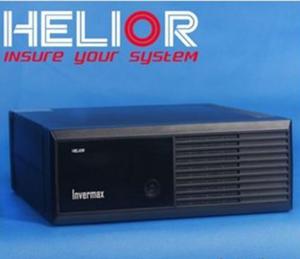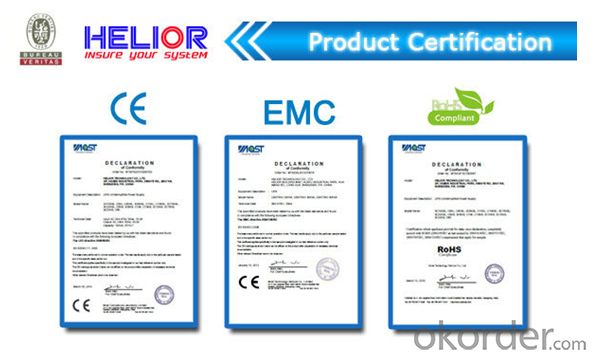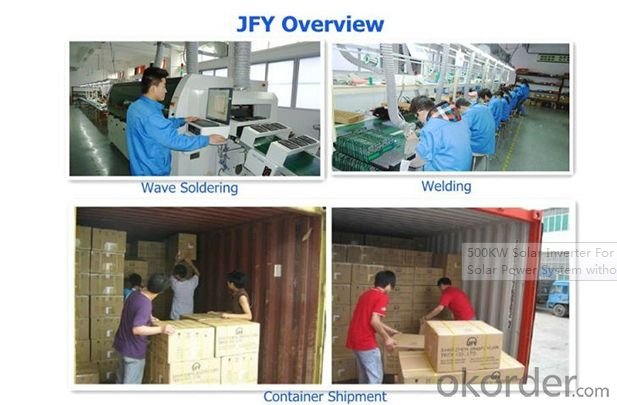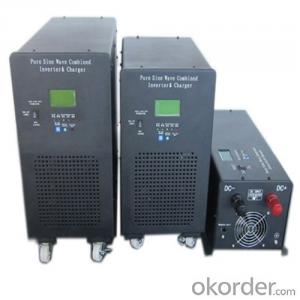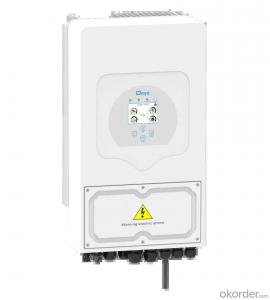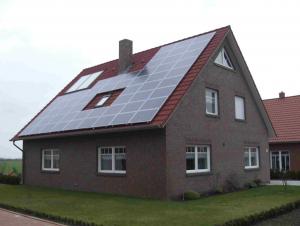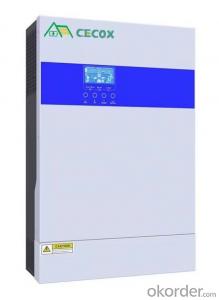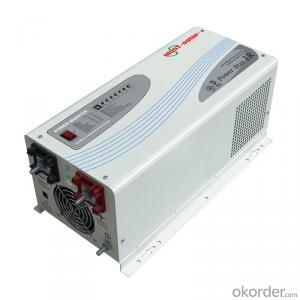Solar Inverter Suppliers - Best MPPT Inverter Hybrid A
- Loading Port:
- Shanghai
- Payment Terms:
- TT or LC
- Min Order Qty:
- 15 unit
- Supply Capability:
- 1000 unit/month
OKorder Service Pledge
OKorder Financial Service
You Might Also Like
1. Structure of Solar Inverter, Best Mppt Inverter Hybrid A Description
A solar inverter, or PV inverter, or Solar converter, converts the variable direct current (DC) output of a photovoltaic (PV) solar panel into a
utility frequency alternating current (AC) that can be fed into a commercial electrical grid or used by a local, off-grid electrical network. It is a
critical BOS–component in a photovoltaic system, allowing the use of ordinary AC-powered equipment. Solar inverters have special
functions adapted for use with photovoltaic arrays, including maximum power point tracking and anti-islanding protection.
2. Main Features of Solar Inverter, Best Mppt Inverter Hybrid A
• High Frequency inverter
• Rack Tower Design
• Off mode charging inverter
• Full automatic and silent operation
• User selectable for accepting wider input voltage
• Compact size for convenient use and storage
• Built-in 8Amp super charger for up to 100Ah battery
• Small Scale and cost effective inverter for home appliances and office equipment
• Two-steps intelligent charging control to reduce the recharging time
3. Power Inverter with Solar Inverter, Best Mppt Inverter Hybrid A Images
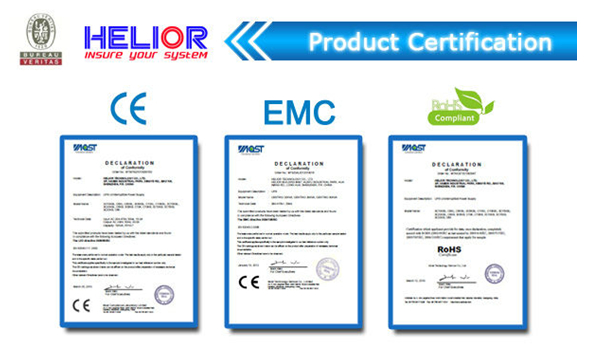
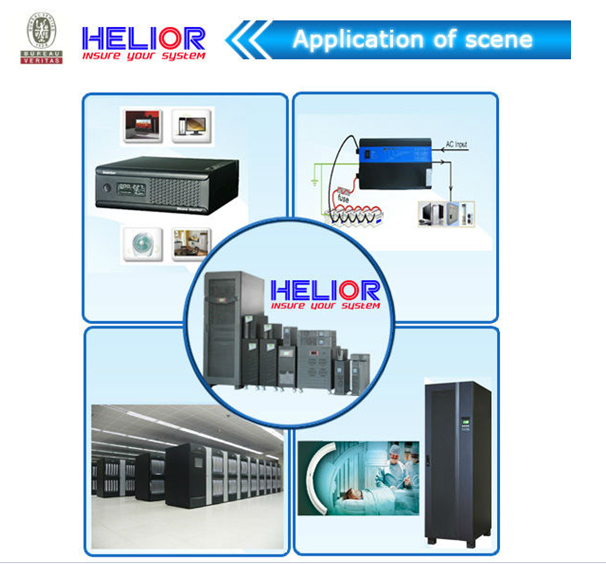
4. Solar Inverter, Best Mppt Inverter Hybrid A Specification
窗体顶端 MODEL窗体底端 |
| INVERMAX 500 | INVERMAX 1000 | INVERMAX 2000 |
CAPACITY | VA/W | 500VA / 300W | 1000VA / 600W | 2000VA / 1280W |
INPUT | Phase | Single | ||
Voltage | 110 / 120VAC or 220 / 230 / 240VAC | |||
Voltage Range | 90 - 145VAC or 170-280VAC ( Narrow Range ) | |||
50-145VAC / 90-280VAC (Wide Range) | ||||
OUTPUT | Phase | Single | ||
Voltage | 120VAC or 230VAC | |||
Voltage Regulation(Batt. Mode) | -0.555555556 | |||
Frequency | 50Hz or 60Hz | |||
Frequency Regulation (Batt. Mode) | +/- 0.1 Hz | |||
Output Waveform (Batt. Mode) | Modified Sinewave | |||
POWER FACTOR | P.F. | 0.6 | ||
BATTERY | Charger Current | 8 Amp + / - 1Amp | 6 Amp + / - 1Amp | 10 Amp + / - 1Amp |
Floating Voltage | 13.7V + / - 0.2V | 27.4V + / - 0.4V | ||
Overcharge Protection | 14.5V +/- 0.3V charger stops and fault | 29V +/- 0.6V charger stops and fault | ||
TRANSFER TIME | Typical | 8ms (Narrow mode) | ||
EFFICIENCY | AC to AC | >95% | ||
DC to AC | >80% | |||
INDICATOR | AC Mode | Green LED lighting | ||
Battery Mode | Yellow LED lighting | |||
Battery Charging Mode | Green LED flashing every 2 seconds | |||
Overload | Red LED flashing every 0.5 second | |||
Fault | Red LED lighting | |||
AUDIBLE ALARM | Low Battery at Battery Mode | Sounding every 2 seconds | ||
Overload | Sounding every 0.5 second | |||
Fault | Continuously sounding | |||
PROTECTION | Full Protection | Deep Discharge, Overcharge, Overload protection, Short Circuit, Battery Shot, Over Voltage and Under Voltage | ||
PHYSICAL | Dimension (DxWxH) mm | 224 X 255 X 80 | ||
Net Weight (kgs) | 1.7 for 500VA / 300W | 2.5 | ||
ENVIRONMENT | Operating Environment | 0~40 Degrees Centigrade, 0~90% relative humidity (non-condensing) | 0~50 Degrees Centigrade | |
Noise Level | Less than 45dB 窗体底端 | |||
5. FAQ of Solar Inverter, Best Mppt Inverter Hybrid A
Q1:Can we visit your factory?
A1:Sure,welcome at any time,seeing is believing.
Q2:Which payment terms can you accept?
A2:T/T,L/C,Moneygram,Paypal are available for us.
- Q: How does the power factor affect the performance of a solar inverter?
- The power factor affects the performance of a solar inverter by determining the efficiency and reliability of the system. A low power factor can result in increased losses and reduced overall efficiency, leading to higher energy consumption and reduced power output. In contrast, a high power factor improves system performance by minimizing losses and maximizing the utilization of available power, resulting in higher efficiency and better overall performance of the solar inverter.
- Q: Why is a solar inverter necessary in a solar power system?
- A solar inverter is necessary in a solar power system because it is responsible for converting the direct current (DC) generated by the solar panels into alternating current (AC) that can be used to power household appliances and be fed back into the electrical grid.
- Q: How do I choose the right solar inverter for my system?
- When choosing the right solar inverter for your system, there are a few key factors to consider. Firstly, you need to determine the size and capacity of your solar panel system. This will help you determine the appropriate power rating for the inverter. Additionally, consider the type of inverter you need - string inverters are suitable for larger systems, while microinverters or power optimizers may be more suitable for smaller or shaded systems. It is also important to check the inverter's efficiency, warranty, and compatibility with your solar panels and battery storage, if applicable. Lastly, consider your budget and any specific features you may require, such as monitoring capabilities or grid-tied functionality. Consulting with a professional solar installer can also provide valuable guidance in selecting the right solar inverter for your specific system.
- Q: Can a solar inverter be used in regions with extreme weather conditions?
- Yes, solar inverters can be used in regions with extreme weather conditions. However, the durability and performance of the inverter may vary depending on the specific weather conditions. It is important to choose a solar inverter that is designed to withstand the extreme weather conditions of the region, such as high temperatures, strong winds, heavy rain, or snow. Additionally, proper installation, regular maintenance, and protection from harsh weather elements can help ensure the longevity and efficient operation of the solar inverter in extreme weather conditions.
- Q: What is the role of a solar inverter in a battery storage system?
- The role of a solar inverter in a battery storage system is to convert the direct current (DC) electricity generated by solar panels into alternating current (AC) electricity that can be used to power homes or businesses. It also manages the charging and discharging of the batteries, ensuring efficient storage of excess energy generated by the solar panels and providing a reliable power supply during periods of low solar generation or power outages.
- Q: Can a solar inverter be used with different types of power conditioning units?
- Yes, a solar inverter can be used with different types of power conditioning units. Solar inverters are designed to convert the DC power generated by solar panels into AC power that can be used by various electrical devices. They can be compatible with different types of power conditioning units, such as battery storage systems or grid-tied inverters, depending on the specific requirements and setup of the solar power system.
- Q: How does a solar inverter handle electromagnetic interference?
- A solar inverter handles electromagnetic interference by incorporating various filtering techniques and components to minimize the impact of electromagnetic interference on its operation. This includes using electromagnetic compatibility (EMC) filters, shielding, and proper grounding techniques. These measures help to reduce electromagnetic emissions from the inverter and also protect it from external electromagnetic disturbances, ensuring reliable and efficient operation.
- Q: How does the maximum AC current rating affect the performance of a solar inverter?
- The maximum AC current rating of a solar inverter determines its capacity to handle and convert the DC power generated by solar panels into usable AC power for the electrical grid. A higher maximum AC current rating allows the inverter to handle larger amounts of power, enabling it to support more solar panels or higher power output. This ensures efficient and uninterrupted performance of the solar inverter, allowing it to meet the energy demands of the system and maximize solar energy production.
- Q: What are the potential risks of fire or explosions from a faulty solar inverter?
- The potential risks of fire or explosions from a faulty solar inverter include short circuits, electrical arcing, overheating, and component failure. These issues can lead to an accumulation of heat, sparks, or electrical discharges, which may ignite flammable materials nearby or cause an explosion. It is crucial to regularly inspect and maintain solar inverters to mitigate these risks and ensure the safe operation of the system.
- Q: Are solar inverters compatible with smart home systems?
- Yes, solar inverters are compatible with smart home systems. Many modern solar inverters come with built-in communication capabilities, such as Wi-Fi or Ethernet connectivity, which allow them to integrate seamlessly with smart home systems. This enables homeowners to monitor and control their solar energy production, consumption, and storage through their smart home devices or applications.
Send your message to us
Solar Inverter Suppliers - Best MPPT Inverter Hybrid A
- Loading Port:
- Shanghai
- Payment Terms:
- TT or LC
- Min Order Qty:
- 15 unit
- Supply Capability:
- 1000 unit/month
OKorder Service Pledge
OKorder Financial Service
Similar products
Hot products
Hot Searches
Related keywords
